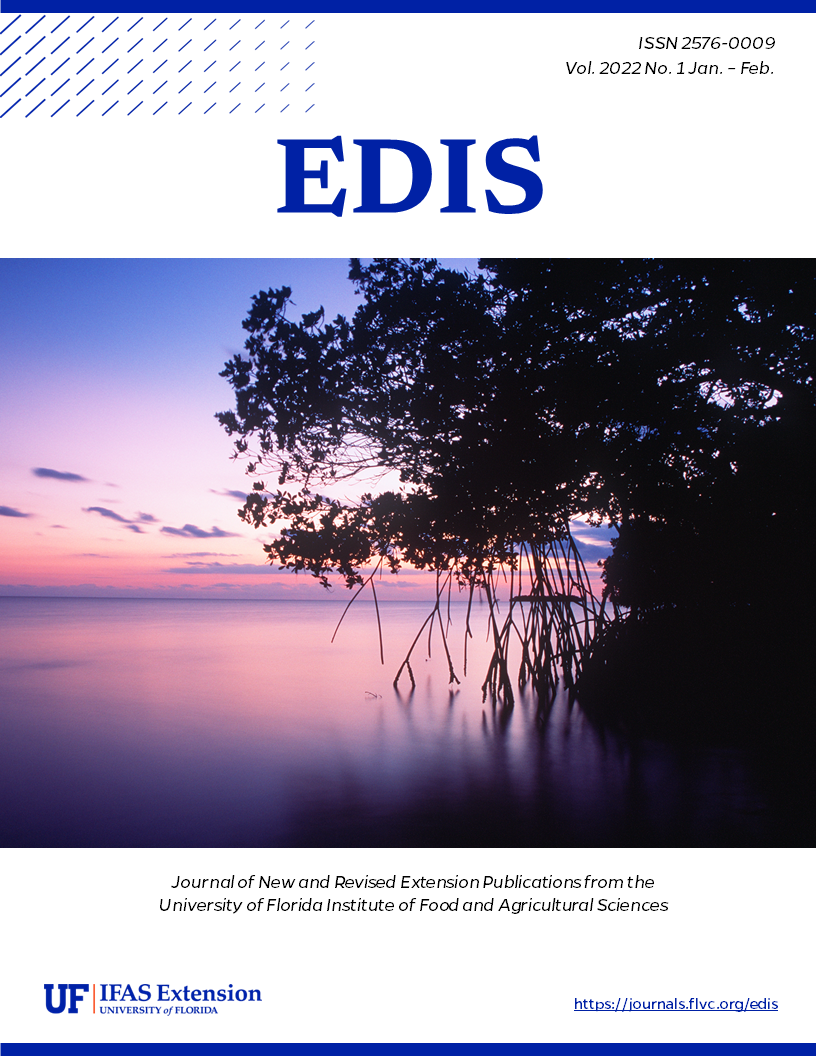Abstract
Mangroves provide quintessential ecosystem services in Florida, where there are three native mangrove species: red mangrove (Rhizophora mangle), black mangrove (Avicennia germinans), and white mangrove (Laguncularia racemosa). Mangroves extend from the Florida Keys up to peninsular Florida along the coastlines.They are often removed or trimmed to capitalize on coastal views valued by residents and visitors. To protect mangroves and the ecosystem services they provide, the 1996 Mangrove Trimming and Preservation Act provides management guidance. A literature review about trimming mangroves uncovered that not all species remain healthy after trimming. To minimize the negative impacts of trimming, landowners should carefully consider the amount of biomass removed, trimming frequency and timing, and best trimming techniques for the mangrove species they are managing.
References
Carlton, J. M. (1974). Land-building and stabilization by mangroves. Environmental conservation, 1(4), 285-294. https://doi.org/10.1017/S0376892900004926
Donnelly, M. J., Green, D. M., & Walters, L. J. (2008). Allelopathic effects of fruits of the Brazilian pepper Schinus terebinthifolius on growth, leaf production and biomass of seedlings of the red mangrove Rhizophora mangle and the black mangrove Avicennia germinans. Journal of Experimental Marine Biology and Ecology, 357(2), 149-156. https://doi.org/10.1016/j.jembe.2008.01.009
Ellis, W. L., & Bell, S. S. (2004). Canopy gaps formed by mangrove trimming: an experimental test of impact on litter fall and standing litter stock in Southwest Florida (USA). Journal of experimental marine biology and ecology, 311(2), 201-222. https://doi.org/10.1016/j.jembe.2004.05.008
Gill, A. M., & Tomlinson, P. B. (1971). Studies on the growth of red mangrove (Rhizophora mangle L.) 3. Phenology of the shoot. Biotropica, 109-124. https://doi.org/10.2307/2989815
Gill, A. M., & Tomlinson, P. B. (1977). Studies on the growth of red mangrove (Rhizophora mangle L.) 4. The adult root system. Biotropica, 145-155. https://doi.org/10.2307/2387877
Lippi, D., Osborne, T. The Consequences of Regulated Trimming and Hurricane Stressors on Secondary Growth, Wound Wood Production, and Chlorophyll Content of Black mangroves (Avicennia germinans). UF IFAS, 1-20. https://soils.ifas.ufl.edu/media/soilsifasufledu/sws-main-site/pdf/technical-papers/Lippi_Daniel_Six_Month_Embargo.pdf
Medina-Irizarry, N., and Andreu, M. (2021). Mangrove Trimming: A Literature Review of Potential Impacts. Florida Department of Environmental Protection, Tallahassee FL, 1-33.
Othman, M. A. (1994). Value of mangroves in coastal protection. Hydrobiologia, 285(1-3), 277-282. https://doi.org/10.1007/BF00005674
Parkinson, R. W., Perez-Bedmar, M., & Santangelo, J. A. (1999). Red mangrove (Rhizophora mangle L.) litter fall response to selective pruning (Indian River Lagoon, Florida, USA). Diversity and Function in Mangrove Ecosystems (pp. 63-76). https://doi.org/10.1007/978-94-011-4078-2_7
Snedaker, S. C., Brown, M. S., Lahmann, E. J., & Araujo, R. J. (1992). Recovery of a mixed-species mangrove forest in south Florida following canopy removal. Journal of Coastal Research, 919-925.

